Market Data

March 8, 2020
February Job Creation Beats Expectations
Written by Peter Wright
In February, job creation beat expectations, and there is no sign of a virus effect even in the details.
Net job creation in February was a surprising 273,000. In addition, December was revised up by 37,000 and January up by 48,000. Rising employment and wages are the main contributors to GDP growth because personal consumption accounts for almost 70 percent of GDP. Steel consumption is related to GDP; therefore this is one of the indicators that help us understand the reality of the steel market. This is not likely to continue as the coronavirus puts a brake on economic activity. COVID-19 will probably be what economists call a black swan—a rare and inherently unforeseeable event with severe consequences. We all hope the global effort to contain the virus will ensure this black swan doesn’t fly, but employers and society are making plans in case it does.
![]()
Figure 1 shows the three-month moving average (3MMA) of the number of jobs created monthly since 2005 as the brown bars and the total number employed as the black line.

Economy.com summarized as follows: “Payroll employment gains surprised on the upside in February, though activity following the mid-month survey week has likely decelerated as coronavirus effects expand. Employers added 273,000 jobs, well above our expectation. Moreover, gains for December and January were revised higher adding another 85,000 jobs. A mild winter boosted construction and leisure/hospitality. Healthcare also grew at a solid pace. The unemployment rate fell to 3.5 percent.”
Figure 1a shows the raw monthly data since January 2018 and that the results have been much less erratic in the last nine months than they were in 2018.
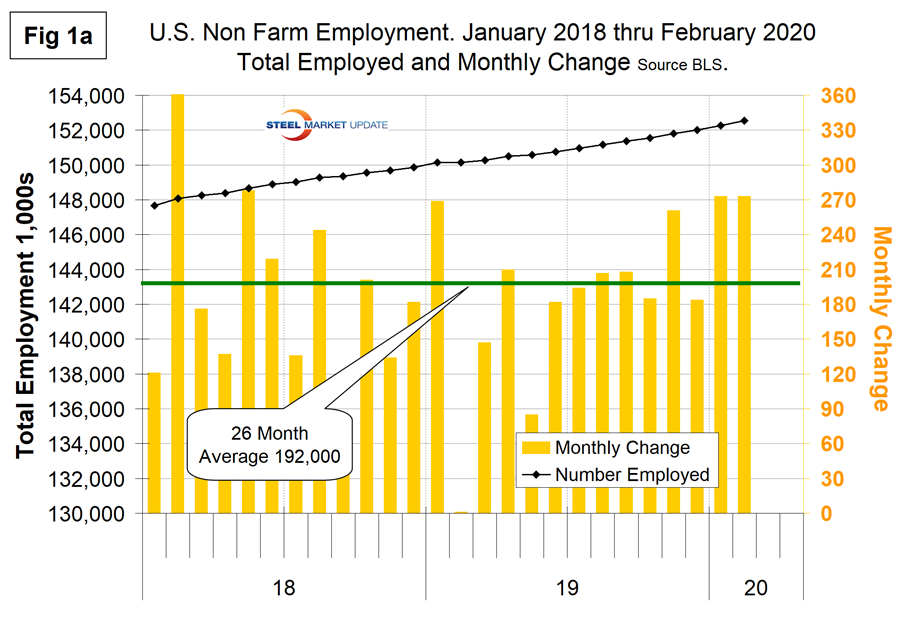
The employment data has been seasonally adjusted. We have developed Figure 2 to examine if any seasonality is left in the data after adjustment. We think it’s significant to look at the results this way because historic variability can give a false impression. In the 10 years since and including 2011, the average month-on-month change from January to February has been positive 23.0 percent. This year the change was zero after the January revision.
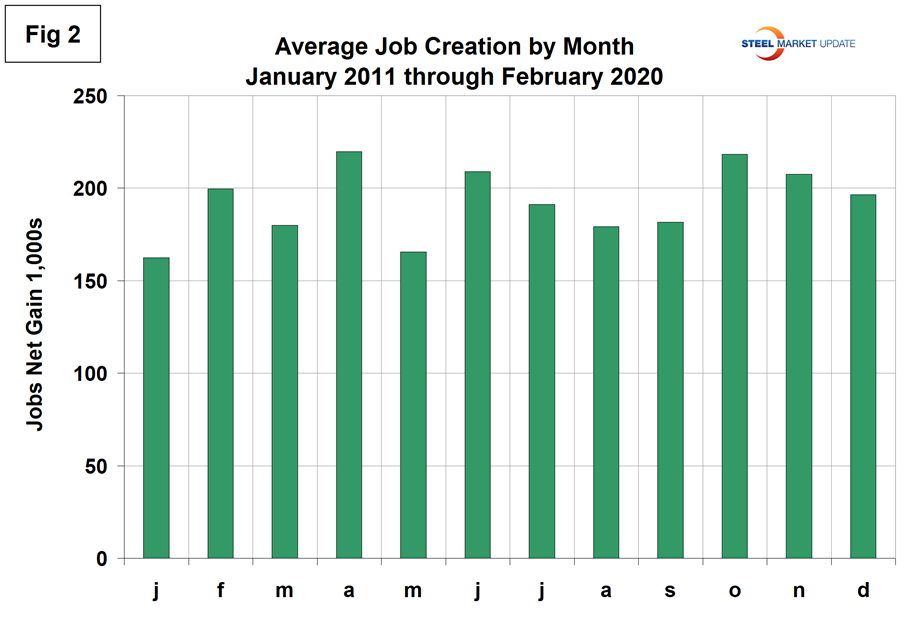
In order to get another look at the degree of change, we have developed Figure 3. This shows the same total employment line as Figure 1, but includes the year-over-year growth on a percentage basis. This presentation shows more clearly the rate of change that has occurred in each of the preceding years. In 12 months through February, the average monthly gain on a year-over-year basis has been 1.4 percent. Considering the residual seasonality after adjustment, we think the year-over-year view is the best way to evaluate what’s really going on.
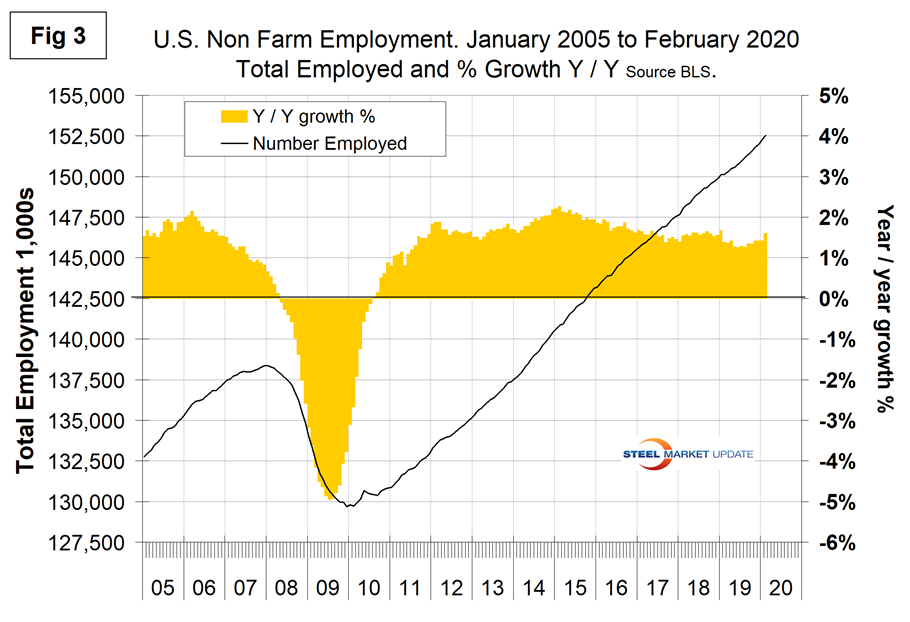
According to the latest BLS economic news release, the average workweek for all employees on private nonfarm payrolls rose by 0.1 hour to 34.4 hours in February. In manufacturing, the workweek increased by 0.2 hour to 40.7 hours, and overtime edged up by 0.1 hour to 3.2 hours. The average workweek for production and nonsupervisory employees on private nonfarm payrolls increased by 0.1 hour to 33.7 hours. In February, average hourly earnings for all employees on private nonfarm payrolls increased by 9 cents to $28.52. Over the past 12 months, average hourly earnings have increased by 3.0 percent. Average hourly earnings of private-sector production and nonsupervisory employees increased by 8 cents to $23.96 in February.
The official unemployment rate, U3, reported in the BLS Household survey (see explanation below) declined from 3.7 percent in June, July and August to 3.5 percent in February. U3 has ranged from 3.5 to 4.0 percent in each of the last 20 months. This is not a very representative number. The more comprehensive U6 unemployment rate at 7.0 percent was down from 8.1 percent in January last year (Figure 4). The difference between these two measures in February was 3.5 percent, which is historically excellent. U6 includes individuals working part time who desire full-time work and those who want to work but are so discouraged they have stopped looking.
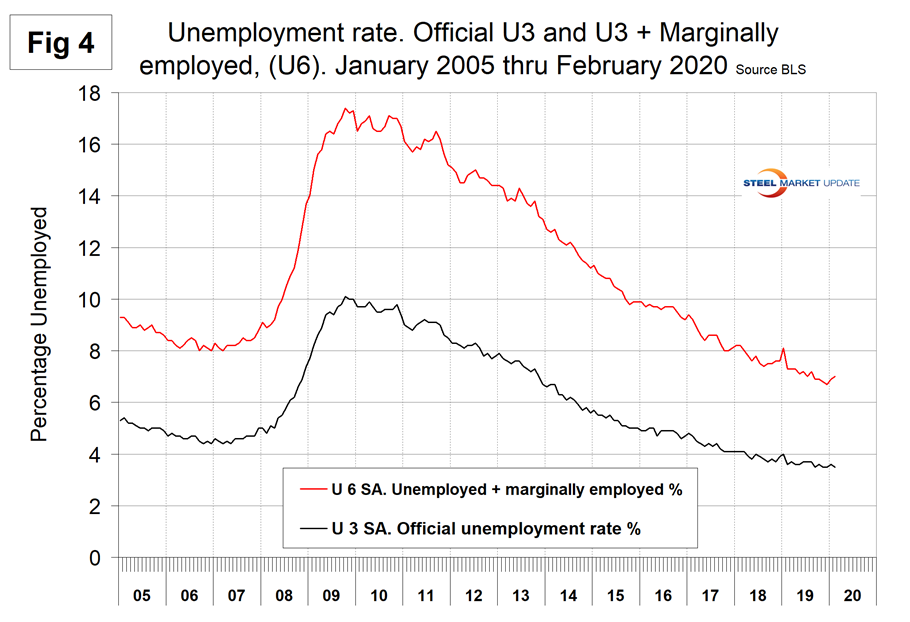
The labor force participation rate is calculated by dividing the number of people actively participating in the labor force by the total number of people eligible to participate. This measure was 63.4 percent in February and hasn’t changed much in three years. Another gauge is the number employed as a percentage of the population, which we think is more definitive. In February, the employment-to-population ratio was 61.1 percent, the best result since November 2008. Figure 5 shows both measures on one graph.
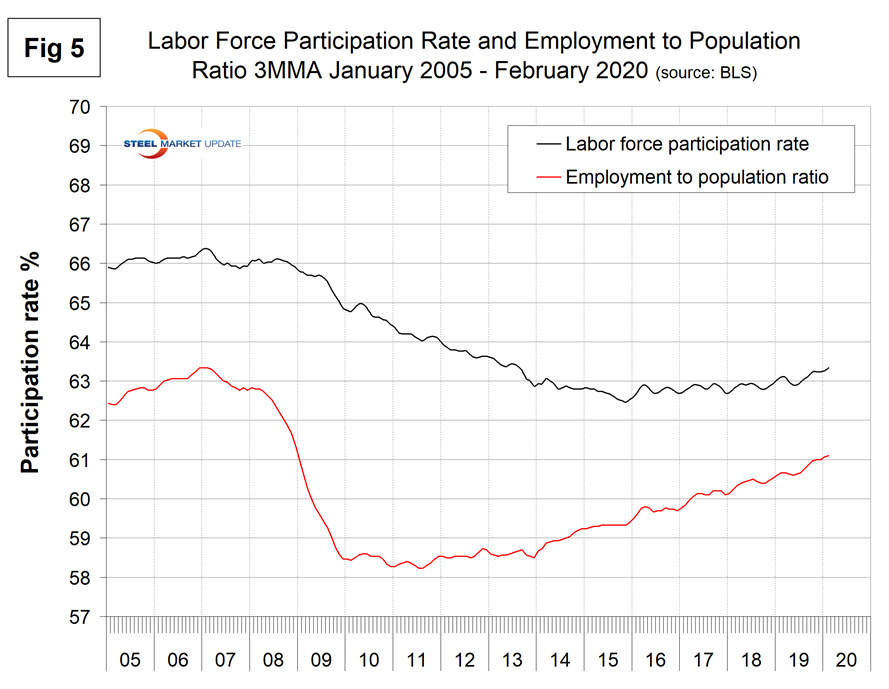
In the 50 months since and including January 2016, there has been an increase of 8,369,000 full-time and an increase of 348,000 part time employees. Figure 6 shows the rolling 12-month change in both part-time and full-time employment. There have historically been huge swings in this data, which is smoothed out by using a rolling 12 months. The full time/part time data comes from the Household survey and part-time is defined as less than 35 hours per week. Because the full-time/part-time data comes from the Household survey and the headline job creation number comes from the Establishment survey, the two cannot be compared in any given month.

The job openings report known as JOLTS is reported on about the 10th of the month by the Federal Reserve and is over a month in arrears. In the February employment report, JOLTS data was reported for December. Figure 7 shows the history of unfilled jobs. In December, openings stood at 6,230,000 which was still historically high but down from 7,625,000 in January 2019.
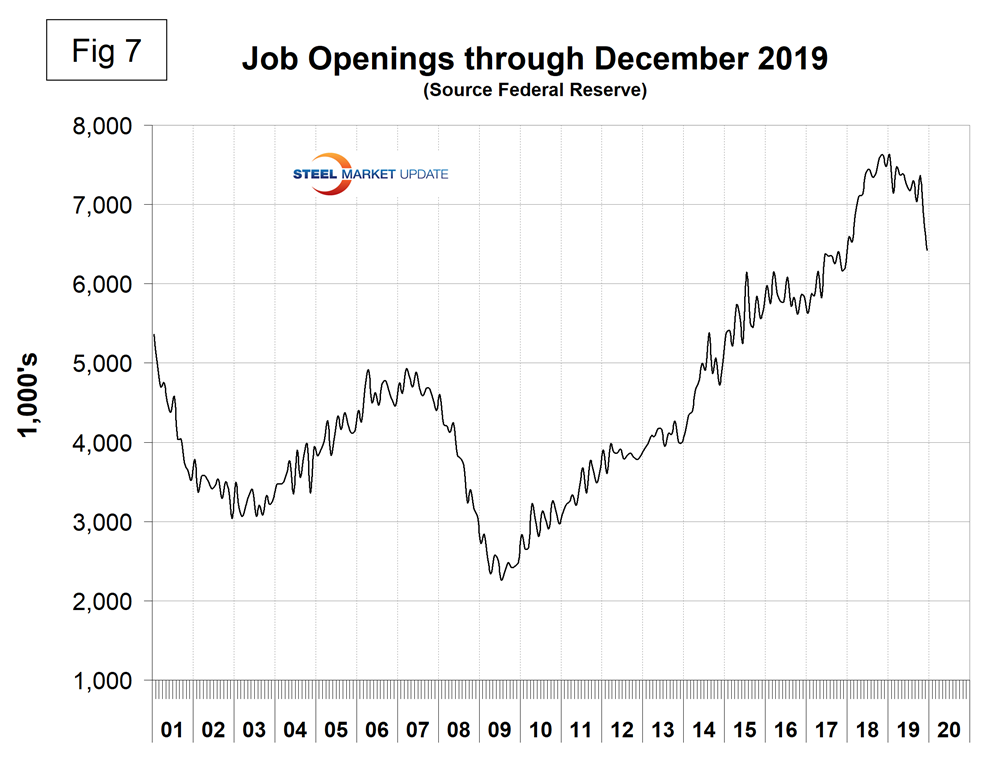
Initial claims for unemployment insurance, reported weekly by the Department of Labor, have been exceptionally low since 2014. The U.S. is enjoying the longest streak since 1973 of initial claims below 300,000 (Figure 8). This data stream is part of our recession outlook report and at present shows no sign of an imminent problem. It is likely that responses to the coronavirus will change this situation.
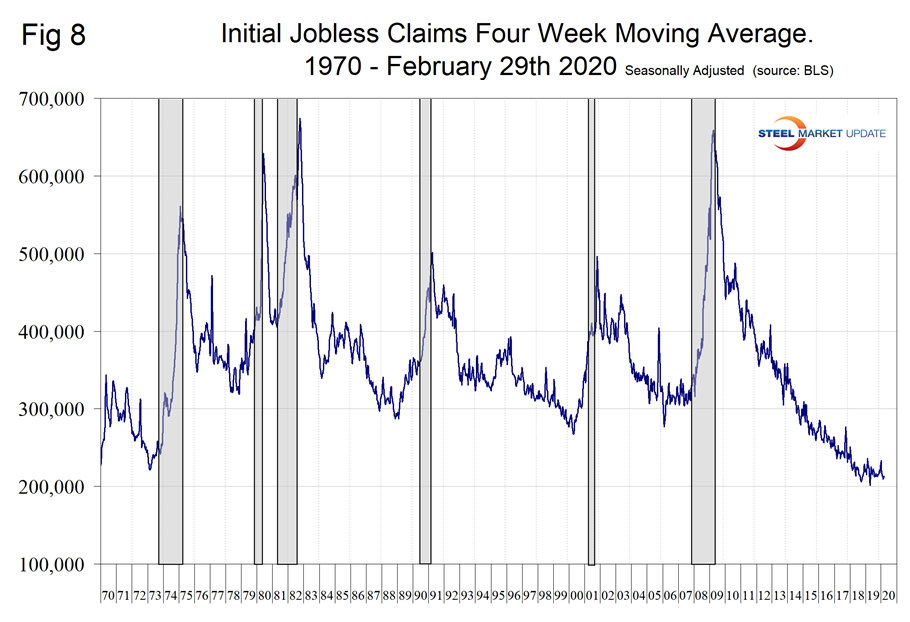
Challenger, Grey and Christmas Inc. produces a monthly report of job cuts in the U.S. Job cuts were 56,700 in February, down from 67,700 in January, which was the highest since October 2018. Figure 9 shows the rolling 12 months of job cuts since December 2007. We use a rolling 12 months because the high variability of this data makes the trend difficult to visualize from a monthly chart or even from a 3MMA. Economy.com reported: “The Challenger Report indicates that job cut announcements fell in February, down 16 percent from the previous month and 26 percent from a year earlier. Through the first two months of the year, technology firms have announced the most total layoffs. The COVID-19 outbreak was not cited by any company as a reason for job cuts, according to the Challenger Report. Job opening announcements were bolstered in February by The Home Depot’s announced plan to hire 80,000 workers.”
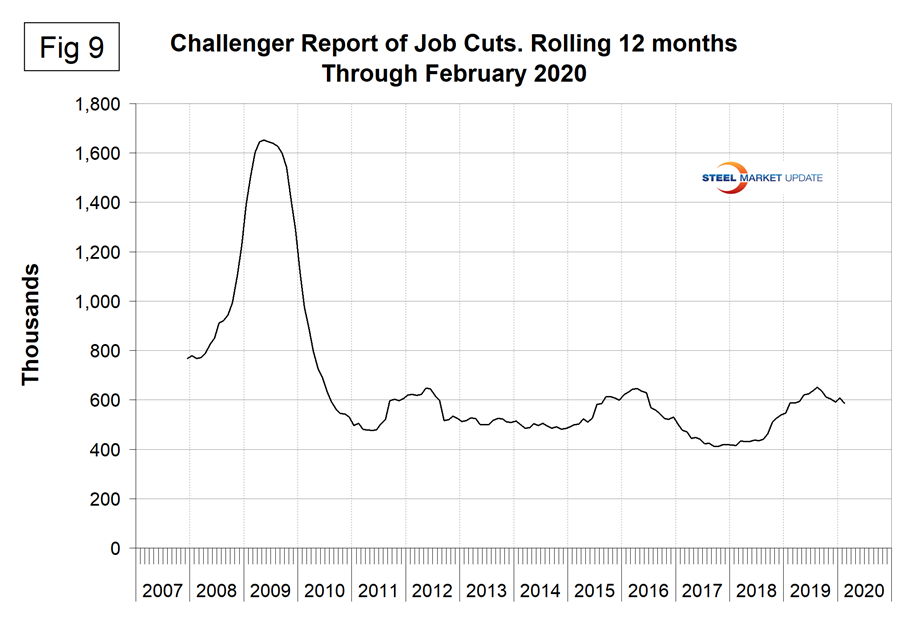
SMU Comment: So far the coronavirus has been a non-event as far as the U.S. employment situation is concerned. Based on global news reports from Japan. Korea, Italy and Iran, we don’t expect to dodge this bullet for many more months, in which case layoffs will accelerate and steel demand will suffer. On Feb. 25, Mark Zandi of Moody’s Analytics wrote: “China’s economy will contract in the first quarter of this year, and growth for the year will be cut by a full percentage point to 5.4 percent. The global economy will suffer a hit to GDP of almost a percentage point (annualized) in the first quarter, and slow by 0.4 percentage point to 2.4 percent in 2020. For context, global potential growth is an estimated 2.8 percent. The U.S. economy will experience growth of only 1.3 percent in the first quarter (annualized), down by 0.6 percentage point because of the virus. Growth in 2020 is now expected to be 1.7 percent, down 0.2 percentage point. The U.S. economy’s potential growth is estimated near 2 percent.”
Explanation: On the first Friday of each month, the Bureau of Labor Statistics releases the employment data for the previous month. Data is available at www.bls.gov. The BLS reports on the results of two surveys. The Establishment survey reports the actual number employed by industry. The Household survey reports on the unemployment rate, participation rate, earnings, average workweek, the breakout into full-time and part-time workers and lots more details describing the age breakdown of the unemployed, reasons for and duration of unemployment. It’s important to understand that none of these numbers is an actual count of everyone employed across the country. No one keeps comprehensive records, and they’re certainly not processed centrally on a monthly basis. All the reported numbers are based on samples of the population. At Steel Market Update, we track the job creation numbers by many different categories. The BLS database is a reality check for other economic data streams such as manufacturing and construction. We include the net job creation figures for those two sectors in our “Key Indicators” report. It is easy to drill down into the BLS database to obtain employment data for many subsectors of the economy. For example, among hundreds of sub-indexes are truck transportation, auto production and primary metals production. The important point about all these data streams is the direction in which they are headed. Whenever possible, we try to track three separate data sources for a given steel-related sector of the economy. We believe this gives a reasonable picture of market direction. The BLS data is one of the most important sources of fine-grained economic data that we use in our analyses. The states also collect their own employment numbers independently of the BLS. The compiled state data compares well with the federal data. Every three months, SMU examines the state data and provides a regional report, which indicates strength or weakness on a geographic basis. Reports by individual state can be produced on request.







